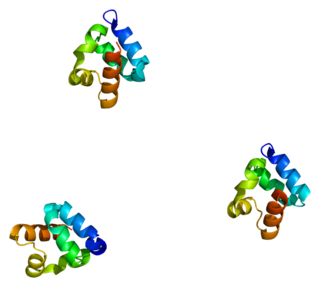
Ankyrins are a family of proteins that mediate the attachment of integral membrane proteins to the spectrin-actin based membrane cytoskeleton. Ankyrins have binding sites for the beta subunit of spectrin and at least 12 families of integral membrane proteins. This linkage is required to maintain the integrity of the plasma membranes and to anchor specific ion channels, ion exchangers and ion transporters in the plasma membrane. The name is derived from the Greek word for "fused".

The ankyrin repeat is a 33-residue motif in proteins consisting of two alpha helices separated by loops, first discovered in signaling proteins in yeast Cdc10 and Drosophila Notch. Domains consisting of ankyrin tandem repeats mediate protein–protein interactions and are among the most common structural motifs in known proteins. They appear in bacterial, archaeal, and eukaryotic proteins, but are far more common in eukaryotes. Ankyrin repeat proteins, though absent in most viruses, are common among poxviruses. Most proteins that contain the motif have four to six repeats, although its namesake ankyrin contains 24, and the largest known number of repeats is 34, predicted in a protein expressed by Giardia lamblia.

Ankyrin Repeat, PEST sequence and Proline-rich region (ARPP), also known as Ankyrin repeat domain-containing protein 2 is a protein that in humans is encoded by the ANKRD2 gene. ARPP is a member of the muscle ankyrin repeat proteins (MARP), which also includes CARP and DARP, and is highly expressed in cardiac and skeletal muscle and in other tissues. Expression of AARP has been shown to be altered in patients with dilated cardiomyopathy and amyotrophic lateral sclerosis.

DNA-binding protein RFXANK is a protein that in humans is encoded by the RFXANK gene.

CARP, also known as Cardiac adriamycin-responsive protein or Cardiac ankyrin repeat protein is a protein that in humans is encoded by the ANKRD1 gene. CARP is highly expressed in cardiac and skeletal muscle, and is a transcription factor involved in development and under conditions of stress. CARP has been implicated in several diseases, including dilated cardiomyopathy, hypertrophic cardiomyopathy, and several skeletal muscle myopathies.

Ankyrin repeat domain-containing protein 27 is a protein that in humans is encoded by the ANKRD27 gene.

Myopalladin is a protein that in humans is encoded by the MYPN gene. Myopalladin is a muscle protein responsible for tethering proteins at the Z-disc and for communicating between the sarcomere and the nucleus in cardiac and skeletal muscle

KN motif and ankyrin repeat domain-containing protein 2 is a protein that in humans is encoded by the KANK2 gene.

Ankyrin repeat domain-containing protein 17 is a protein that in humans is encoded by the ANKRD17 gene.

SH3 and multiple ankyrin repeat domains 3 (Shank3), also known as proline-rich synapse-associated protein 2 (ProSAP2), is a protein that in humans is encoded by the SHANK3 gene on chromosome 22. Additional isoforms have been described for this gene but they have not yet been experimentally verified.

KN motif and ankyrin repeat domain-containing protein 1 is a protein that in humans is encoded by the KANK1 gene.

Ankyrin repeat domain-containing protein 13C is a protein that in humans is encoded by the ANKRD13C gene.

Ankyrin repeat domain-containing protein 23 is a protein that in humans is encoded by the ANKRD23 gene.

Ankyrin repeat domain-containing protein 26 is a protein that in humans is encoded by the ANKRD26 gene. This protein has a function that is not currently understood.
Ankyrin-B, also known as Ankyrin-2, is a protein which in humans is encoded by the ANK2 gene. Ankyrin-B is ubiquitously expressed, but shows high expression in cardiac muscle. Ankyrin-B plays an essential role in the localization and membrane stabilization of ion transporters and ion channels in cardiomyocytes, as well as in costamere structures. Mutations in ankyrin-B cause a dominantly-inherited, cardiac arrhythmia syndrome known as ankyrin-B syndrome as well as sick sinus syndrome; mutations have also been associated to a lesser degree with hypertrophic cardiomyopathy. Alterations in ankyrin-B expression levels are observed in human heart failure.

Ankyrin repeat domain-containing protein 24 is a protein in humans that is coded for by the ANKRD24 gene. The gene is also known as KIAA1981. The protein's function in humans is currently unknown. ANKRD24 is in the protein family that contains ankyrin-repeat domains.

Ankyrin repeat domain 31 is a protein that in humans is encoded by the ANKRD31 gene.

Ankyrin repeat domain 11 is a protein that in humans is encoded by the ANKRD11 gene.

Ankyrin repeat domain 33 is a protein that in humans is encoded by the ANKRD33 gene.

Ankyrin repeat domain 22 is a protein that in humans is encoded by the ANKRD22 gene.













